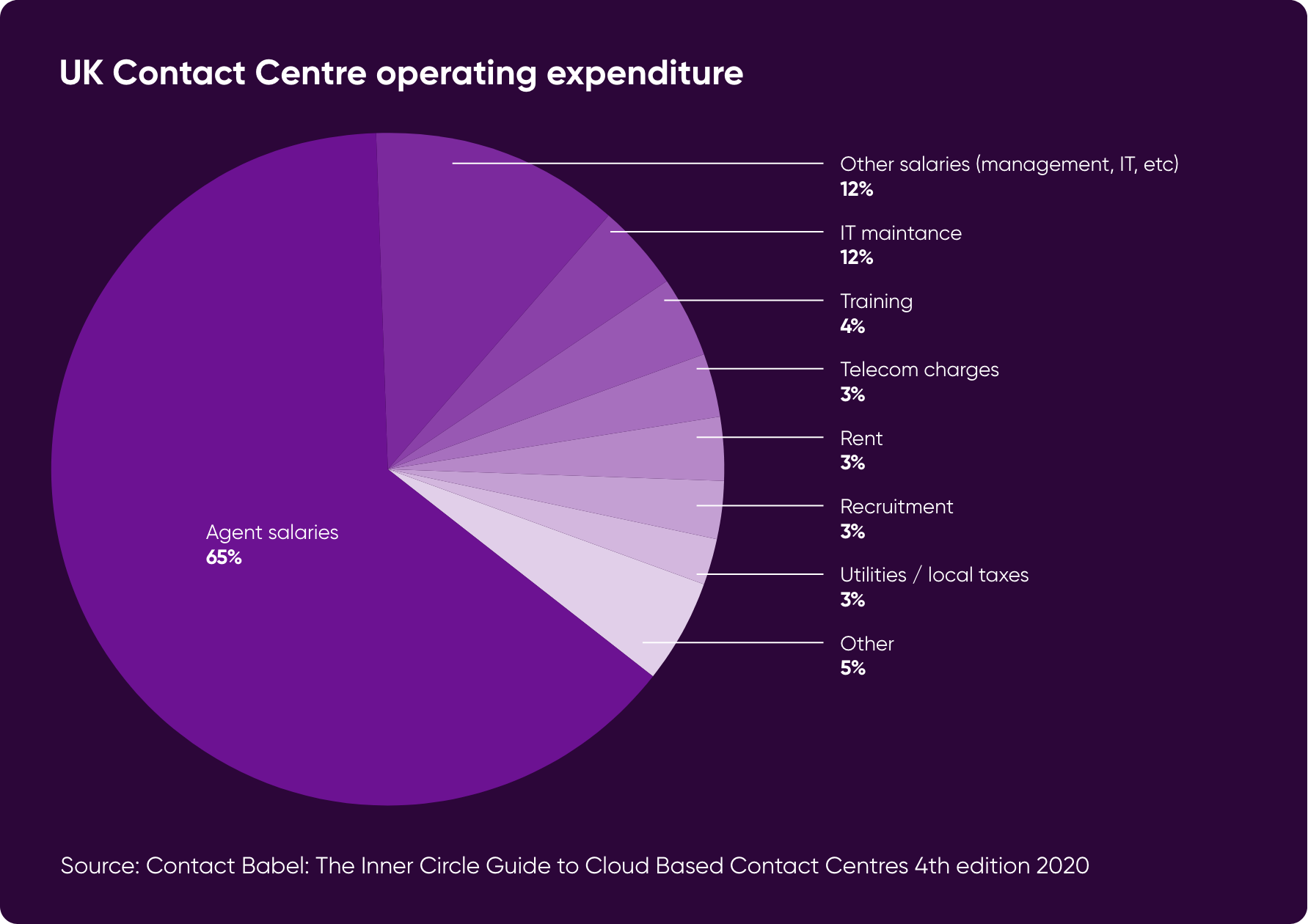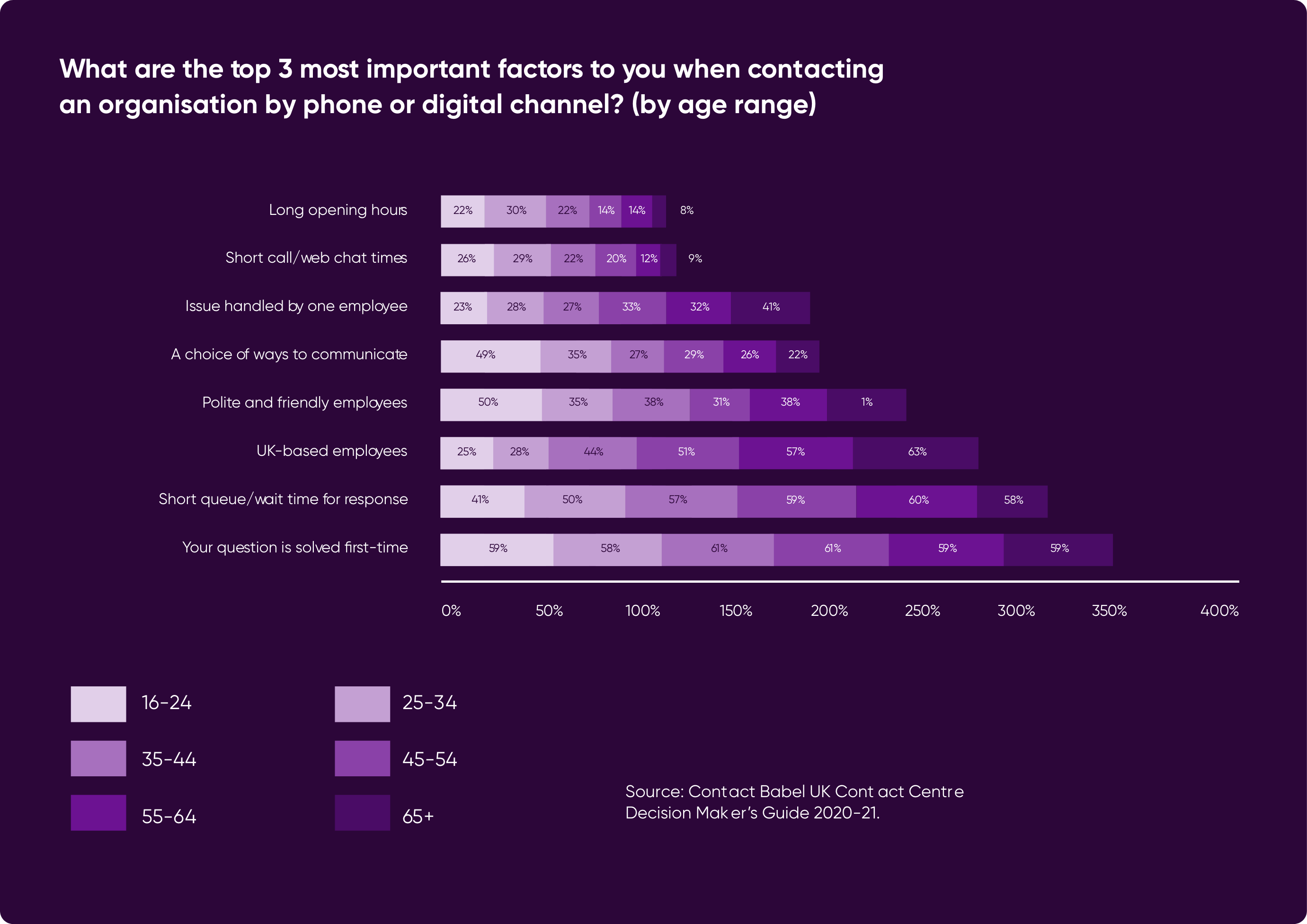Contact Centres: Building the Business Case for Cloud
Coronavirus changed contact centres
Coronavirus catapulted contact centres years into the future. It has been the catalyst for change which could otherwise have taken decades to sweep through the industry. Instead, the pandemic brought change overnight, in some cases quite literally. While some operators have been slower to make the shifts required to cope with our changed world of work, very few operations have remained as they were pre-pandemic.
Contact centres have had to deal with dual pressures – changed workforce and operational priorities as well as significantly altered customer demands. Overall, however, the pandemic simply accelerated the direction in which many contact centres were already moving. The result is the adoption of fresh business strategies and new systems and technologies which will reap rewards long after the threat from the virus, hopefully, recedes.
One of the key shifts has been the move to cloud technology. This has enabled remote working for large and small employers alike, while the adoption of cloud-based collaboration, AI, analytics and workforce management tools have ensured smooth and efficient working for many businesses through a period of distinct uncertainty for employers, employees and customers.
Put simply, there has never been a more important time for operators to look to the cloud.
A recent study suggests that 1 in 10 contact centres are now fully cloud-based, while 8 out of 10 are increasing deployment of additional cloud-based software (https://fournet.co.uk/embracing-world-of-work-guide).

Why? Because cloud-based services bring agility and flexibility for a business and its workforce. The cloud allows organisations to adjust in real-time to an evolving world of work. Cloud-based solutions not only allow virtual contact centres and seamless workforce flexibility, anytime, anywhere, but integrated technology solutions, data systems and analytics capabilities help operators to understand and forecast requirements and priorities.
Cloud-based contact centres can provide the same seamless user experience and customer experience, no matter from where employees are working – office or home-office.
The pandemic has proved, beyond doubt, that agility is key to success. And agility is built into the cloud with the added bonus that it will deliver:
- Significant cost savings
- Increased efficiency
- Improved customer experience
Building the Business Case
Contact centres in every sector are feeling the pressures posed by COVID, the changed workforce environment and changed demands from customers.
In the face of increased pressure to control costs, moving operations to the cloud has a significant impact in reducing costs and improving efficiency of agents, no matter where they are working from.
Cost Savings: Salaries
Around two-thirds (64%) of the average UK contact centre’s operating expenditure goes on agent salaries, according to a 2020 report by Contact Babel. Another 12% is spent on other salaries, management and IT. Reducing salary costs will therefore have a big impact on overall expenditure.
Capitalising on the latest capabilities offered by cloud solutions not only delivers improvements in agent efficiency, which agent efficiency, on which we go into detail in the Operational Efficiency section, but can also deliver direct cost savings.
Switching to cloud-based solutions means that operators can be more flexible with agent staffing, potentially lowering costs with remote-working, and considering demand-driven shifts.
Other salary costs, such as IT, can also be reduced as there is no need for on-site hardware and maintenance requirements will be lower. Cloud-based solutions also offer opportunities for multi-site management and a reduced need for floor- walking by supervisors.

Workforce Optimisation
Workforce Optimisation (WFO) or Workforce Management (WFM) tools have been key to operational efficiency recently as contact centres have faced changes in working patterns and remote working due to COVID-19. These tools give employees the ability to swap shifts and see updated work schedules in real time.
Automated omnichannel quality management processes also provide a range of tools for managers, from scoring evaluations to assigning training. This shifts resources from manual monitoring and management tasks to higher-value activities and saves time for supervisors and managers.
In addition, WFM and speech analytics tools can identify stressed or vulnerable employees, allowing targeted interventions to safeguard agent and employee wellbeing whether they are home or office based. These can improve agent efficiency and reduce agent attrition while allowing employers and managers to support their agents.
ICT Expenditure
The pay-as-you-go financial model allows organisations to move away from high up-front expenditure to more manageable spending without the risks of budget overruns. It enables a budget shift from capital expenditure (Capex) to operational expenditure (Opex) negating the need for an upfront, lump sum capital investment.
A switch to cloud technology also means that many line items on the IT budget are no longer required: from PBX maintenance and support, through ongoing software upgrades to calls and lines spend; everything can be switched to a simple per agent per month licence cost.
Get in touch to schedule an ROI session with one of our solutions consultants. We will help you full out the full Total Cost of Ownership (TCO) for your existing solution and plot this against the simple per user modular licencing of Agile Cloud. You can either bank the savings or invest in additional features and functionality for users.
Virtualisation
A virtual contact centre provides to agents all the same systems, tools and resources as they’d have sitting in an office environment. It enables agents and other employees to work from home, with little or no adverse impact to the business. It provides a pool of skilled resources that can be used in whatever location, across multiple sites and teams.
Agents can be used more efficiently, eradicating operational issues which, in a siloed office, can often mean some teams being over-stretched while others are sitting idle. Virtual contact centres allow different teams to pick up work from one another, improving agent efficiency and reducing costs, while enhancing customer experience and call-wait times.
For instance, FourNet’s Connecting Wales communications and contact centre framework for the Welsh public sector allows the services of Welsh language agents, who are generally located in the areas of Wales where Welsh is spoken more widely, to be shared by councils in areas where Welsh language is less prominent. This saves council budgets and enables more efficient staffing.
Enhanced operational efficiency
Our contact centre works fine, so why modernise? It’s a question many finance and procurement heads, even IT and contact centre managers might ask. Why spend money on the contact centre when it’s salaries which cost the most?
Unfortunately, customer expectations do not stand still. Your customers expect a much more efficient service than before. In addition, modernising your systems and moving to cloud will significantly boost your performance and revenues, as agent efficiency improves with technology and artificial intelligence solutions and overall costs decline.
First contact resolution
Few things irritate customers more than having to make multiple attempts to find the answers to their problems. A third of customers will walk away after just one bad experience.
When agents are able to resolve issues on first contact, customers are generally left more satisfied. According to Invesp, improving customer retention rates by just 5% can increase profits by between 25% and 95%.
Cloud-based contact centres offer a multitude of solutions to deliver first
contact resolution and increase agent efficiency. This can be through artificial intelligence (AI) tools which offer agent assistance, speech analytics or knowledge management tools. Agents can have immediate access to subject-matter experts who, often, aren’t in the same contact centre but will appear so to the customer.
Reducing call handling time
Intelligent call routing allows customers to be directed to the agent most likely to be able to respond to their enquiry. This speeds up the response time for each call and increases the number of calls being handled by each knowledgeable agent.
Repetitive enquiries can be dealt with by chatbots and AI assistants, via email and instant chat or handled swiftly by human agents through digital channels rather than call handling.
Knowledge management systems can provide agents with ways to swiftly handle calls.
Single customer view
Giving agents access to a customer’s history across all channels and customer contact points, can improve efficiency and enhance customer experience and retention. This means that even if the customer begins their enquiry via webchat or email, when the channel of communications transitions to a phone call, the agent has all the details at their fingertip.
According to research for Contact Babel, it can take more than 30 seconds for agents to bring themselves up to speed on a customer’s previous history. Reducing that time will improve efficiency and boost annual savings. But surprisingly, nearly half of contact centre agents (48%) don’t have access to a full view of personalised customer information.

Source: Contact Babel: The Inner Circle Guide to Cloud Based Contact Centres 4th edition 2020
Reduce time switching between screens
According to a Contact Babel study in 2018/2019, 63% of contact centre operators reported that their agents spent over 10% of their time during a call, moving between screens and applications, and those in housing, finance, utilities and manufacturing were most likely to report the greatest amount of time spent doing this.
Single pane of glass solutions allow agents access to all systems on one screen, removing the need to waste time switching between screens and solutions. Contact centre agents can focus quickly and efficiently on more complex customer calls, with customers’ details and history visible on a ‘single pane of glass’, without the need to switch screens constantly.
Self service and AI
Multi-channel options for communication make it easier for customers to get in touch by telephone, email, webchat or social media, with contact centre agents able to deal with all methods of contact.
Virtual assistants, artificial intelligence (AI) Interactive Voice Response (IVR) and chatbots provide convenience for customers and remove the simple, most repetitive and time-consuming interactions from human agents, allowing them to focus on more complex enquiries.
Recent projects have seen up to a 43% reduction in the volume of live chat requests that can now be handled by AI chatbots.
Improved customer experience
Customers already had increasingly high expectations and demands, due to the speed and convenience of online transactions and interactions. But the pandemic has sent those expectations skywards and the majority (3 in 4) of contact centre operators surveyed by Calabrio suggest those expectations won’t decline in line with the threat from coronavirus.
Customers want multiple channels for communication, emotional empathy and
a need to feel heard. Businesses and contact centres which therefore focus on improving customer experience in line with increased expectations are more likely to improve customer retention levels and cross-selling opportunities.

Increased customer retention
Research by Aurora Market Research into 1,000 UK consumers commissioned by Contact Babel identified the most important factors to a customer when contacting an organisation:

First contact resolution and a short wait time for a response were the top two most important criteria across all age groups (apart from UK-based employees for the over 65s). Investing in cloud solutions that increase First Contact Resolution, enable self-service and reduce handling times that not only deliver operational efficiencies but will also contribute to an improved customer experience.
Giving your customers what they want, and the ability to get in touch how and when they choose, will increase revenue and customer retention.
Public sector commercial opportunities
Cloud-based technology enables the public sector to offer enhanced services to citizens – omnichannel contact and self- service options are as available to local authorities and health boards as they are to popular high street brands.
New income-generating opportunities for local authorities are also emerging. In Wales, for instance, FourNet’s Community Cloud platform has enabled new commercial services to spring up via the Connecting Wales framework.
A new demand responsive bus service, fflecsi, allows customers to book COVID-19 safe travel by bus. Using a smart phone app, passengers set their own pick up and drop off points.
The Transport for Wales service, which operates through local bus operators, was set up in a matter of weeks thanks to a swiftly established contact centre booking service on the Connecting Wales platform.
Because of the virtual nature of the Community Cloud contact centres, services can quickly be scaled up, or down, while agents in multiple locations – with the correct training – can be utilised for different services, depending on demand.
What cloud fits best?
Cloud technology increases efficiency, flexibility, security and competitiveness. It gives organisations greater control over their resources, is easy to scale up or down based on demand and enables a business or organisation to future-proof itself. Organisations and contact centres are becoming much more reliant on building a flexible workforce and cloud technology enables this shift.
FourNet prides itself in tailoring solutions to meet customer needs. Depending on your business or organisation, there are a variety of options available.
Community Cloud
Enabling the delivery of shared services across the public sector. FourNet’s pioneering Community Cloud platform provides a shared communications and contact centre platform to public sector bodies, housing associations and not-for- profit organisations.
This shared cloud-based service removes the risks for the public sector in testing new and ever-developing technologies, reduces the barriers to collaboration, while enabling the sharing of scarce resources, services and even personnel.

A Community Cloud solution provides a range of communications, collaboration and contact centre capabilities. It delivers contact centres capable of handling calls and multi-channel communications through voice, email, webchat, SMS and social media, and is fully AI enabled. It provides integrated collaboration capabilities that bring citizen-facing and back- office employees together: incorporating presence and IM, audio and video conferencing, screen and document sharing. Virtual shared services can be delivered across any number of geographic locations: office, hub or home.

Our award-winning Community Cloud platform, ANTENNA, currently provides services to nearly 40,000 central government employees in more than 30 government departments and agencies and is designated part of Britain’s Critical National Infrastructure. It saves taxpayers millions of pounds by helping to deliver key government targets on cost savings, increased collaboration and improved citizen experience.

Our Connecting Wales platform, which was officially launched at the end of last year, is already changing the way local authorities deliver their services. Available to all councils and public sector organisations across Wales, the framework enables easy procurement of the latest communication, collaboration and contact centre capabilities via the cloud.
During the pandemic, the agile nature of Connecting Wales allowed local authorities and health boards including Vale of Glamorgan Council and Cardiff and Vale University Health Board to establish new contact centre services, from scratch, within weeks, with remote working a built-in feature.
Private Cloud
FourNet’s Private Cloud solutions are tailor-made to meet customer’s needs. Whether it’s a single location business or a multi-national entity, our private cloud- based contact centre solutions improve agent efficiency, user and customer experience, and deliver substantial operational savings.
Available as a pay-as-you-go, pay-per-user service, our private cloud replaces the need for upfront capital investment and allows operators to manage their own costs throughout the year. It reduces the cost of managing on-premise systems, while being agile and ready to accommodate future developments.

FourNet’s award-winning Private Cloud solution proved the answer to energy giant npower’s demands for a modern, efficient solution. The electricity generator and supplier’s 12 international and UK contact centres now run on a pay-per user cloud solution which has delivered significant operational savings for their business. More than 1,200 agents were transitioned to our Private Cloud in one weekend.
npower was provided with a cloud-based contact centre, which connects up voice calls, emails, SMS and webchat, and which automatically routes calls to the best agent, giving customers self-service options, such as secure bill payment through a phone keypad. The solution provided a customer journey-driven experience, improving both customer satisfaction scores and customer retention.
New automated features have significantly boosted the efficiency and productivity of npower’s 5,000 agents, enabled homeworking for contact centre staff, and rapid flexing of resources to respond to peaks in customer demand.
Agile Cloud

Agile Cloud combines the performance, security and feature-rich functionality of a private cloud solution with the scalability, simplicity and on-demand commercial model of a public cloud platform.
Our Agile Cloud solution is an award-winning cloud platform that delivers innovative Unified Communication and Contact Centre services to public and private sector customers across the UK and beyond. Trusted by a wide range of organisations, our Agile Cloud enables our customers to manage the risk and complexity of migrating services to the cloud at their own pace.
Built in tier 4, UK data centres in London and Manchester and managed by expert technical and operational staff, FourNet’s award winning Agile Cloud solution is built on best-of-breed technology. Agile Cloud provides secure infrastructure: from our data centres to a customers’ office locations, remote users and public cloud deployments.
